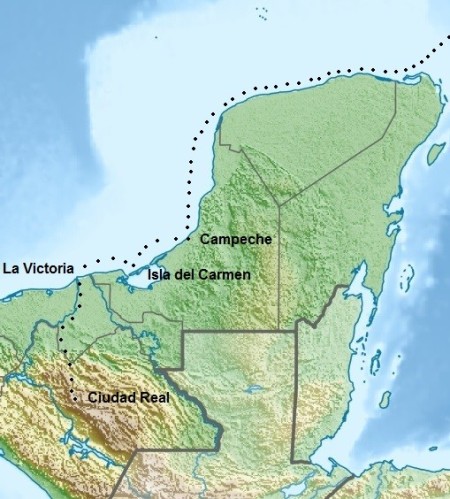Multiples adventures
Dominicans and Franciscans in Maya land - XVIth century
A trip by Las Casas to Tabasco and Chiapas
Pedro de Barrientos in Chiapa de Corzo
Las Casas against the conquistadores
Fuensalida and Orbita, explorers
Numerous studies
An ethnologist friar, Diego de Landa
Two teachers, Juan de Herrera and Juan de Coronel
Two historian friars, Cogolludo and Remesal
A multitude of buildings
A Franciscan turned architect: Friar Juan de Mérida
The Valladolid convent in the Yucatán
The Izamal convent and its miracles
In the Yucatán, a church in every village
A Dominican nurse, Matías de Paz
A difficult task: evangelization
The creation of the monastery of San Cristóbal
The Dominican province of Saint-Vincent
An authoritarian evangelization
Franciscans and the Maya religion
The failure of the Franciscans in Sacalum, the Yucatán
Domingo de Vico, Dominican martyr
The end of the adventure
Additional information
The Historia Eclesiástica Indiana of Mendieta
The road of Dominican evangelization in Guatemala
The convent of Ticul, as seen by John Lloyd Stephens
The Franciscans in the Colca valley in Peru
The convent route of the Yucatán in the XVIth century
The dominican mission of Copanaguastla, Chiapas
Available upon request: -
general information upon Maya countries, - numbered texts
on the conquest and colonization
of Maya countries
Address all correspondence to:
moines.mayas@free.fr
|
A TRIP BY LAS CASAS TO TABASCO AND CHIAPAS
|
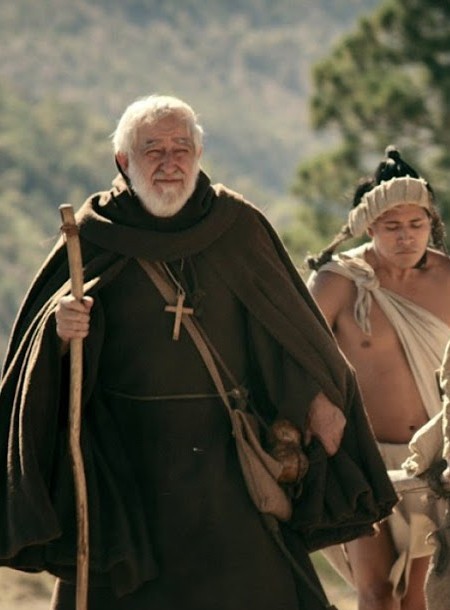
Bartolomé de Las Casas on the road, personifyed by Juan Carlos Colombo in the mexican film "La carga", directed by Alan Jonsson Gavica, 2016
An endless journey
Bartolomé de las Casas who was ordained Bishop of Chiapas, left for another trip to America, accompanied by fifty Dominican friars who were requested to evangelize the Maya Indians. The trip took almost a year and was marked by dramatic incidents.
-July 11, 1544: boarding at San Lucar de Barrameda
-September 9, 1544: arrival in Santo Domingo, after a stopover in the Canary Islands
-January 20, 1545: shipwreck off Términos (isla del Carmen) during the crossing between Campeche and Tabasco
-February 12, 1545: arrival in Tabasco (now La Victoria), then up the Grijalva River in a canoe and one of its affluent to Tacotalpa
-March 12, 1545: arrival in Ciudad Real (San Cristobal de Las Casas) after crossing the mountainous regions inhabited by the Zoque Indians.
Itineraries followed by Las Casas
The Dominicans, crossing the Atlantic, from San Lucar de Barrameda to Santo Domingo
“To help those who are unfamiliar with life at sea understand something of the hardship and suffering that it entails, especially at the outset, I shall set forth a few circumstances that are perfectly obvious to anyone who has been to sea. First of all, a ship is a very narrow and stout prison from which no one can escape even if he wears no shackles or chains. In its cruelty it makes no distinction of its inmates, keeping them all equally confined. Closely crowded in cramped quarters, heat and suffocation are unbearable. The deck floor is usually one’s bed, and though some passengers brought soft mats, ours were small, hard, and bad, thinly stuffed with dog hair, and our bed covering was extremely wretched goatskin blankets. Moreover, there is so much nausea and vomiting on shipboard that some passengers move about as if in a trance and are very peevish.
Some remain in this state for long periods, others for a shorter time, and still others continuously. No one has the least desire to eat and can hardly face anything sweet. The thirst that one endures is unbelievable, and it is increased by our fare of hardtack and salt beef. Water is measured out a half azumbre [about a liter] a day; wine is drunk by those who happen to have it. An infinite number of lice eat one alive, and clothing cannot be washed because salt water shrinks it. Everywhere bad odors pervade the ship, especially below deck, and the stench becomes intolerable when the ship pump is working. This operation varies according to whether the sailing is smooth or not, but it goes at least four or five times each day, pumping out the water that has leaked into the hold, and it smells very foul indeed. These annoyances and many other hardships are very common in shipboard life, but we feel them more keenly because they are so alien to what we are accustomed to.
In addition to the foregoing discomforts, when one feels well enough there’s no place anywhere on the ship where one can study or withdraw to himself; one remains eternally seated since there is no place to stroll or move about. Everything must be done sitting down or sprawled out, or perhaps standing up for a short while. Besides all these discomforts, death is forever before our eyes with only the thickness of one plank sealed to another with pitch separating us from it.”
(Friar Thomas de la Torre, Diario de viaje de Salamanca a Chiapa, 1544-1545)

Fray Bartolomé de Las Casas, Historia de las Indias, Editora Nacional, México, 1951
Once in Campeche, in the Yucatán, the Dominicans were divided into two groups. A first group left on a boat that was to sail along the coast of Campeche up to the mounth of the Grijalva River in Tabasco (this region is covered by wetlands and a road was built only at the beginning of the XXth century). The group was caught in a storm.
The Dominicans’ boat is not secure
“On Monday, it rained hard all day long and as they could not hide in the uncovered boat, they were completely soaked and unable to prepare food. That same day, in the afternoon, the north wind started blowing […]. When the wind rose, they were all half asleep in the boat and, although they ran as fast as they could to the pump to remove the water that penetrated the bow of the boat and kept rising, they could not remove the water which gradually soaked the salt and the clothes. The boat sank before they could notice it, and they could not convince the sailors to throw anything overboard, not even a piece of cloth. The only thing they did was to steer the sails so the wind could carry the boat to land, but even that did not help, because with the wind, the darkness and the agitation of all, nobody knew where they were”.
Nine clerics drown during the storm
“With that came a great wave that passed over the boat, overloaded and already immersed in water, and it filled it even more up to their chest and the pressure caused the boat to fall on her side, crashing most of the crates that were on the deck, as well as throwing overboard all the people, especially Friar Agustin de Hinojosa, Friar Felipe del Castillo, and Friar Pedro de los Reyes. A young man named Segovia, who had come to serve the fathers and accompanied them from Spain, was a great swimmer, and he jumped in the water to rescue them, calling their names loudly: he looked and looked again and, seeing no one, returned to the boat. Friar Dionisio Vertabillo clung to the mast, surrounded by lay people who had tied themselves together, confessing their sins aloud, for there was no time to confess privately. The father blessed them and told them to turn to God and ask for forgiveness, and he was saying this when an even stronger wave completely turned the boat over and threw everyone in the water, himself and the lay people, and they all perished.

Shipwreck near the island of Carmen
Friar Jerónimo de Ciudad Rodrigo and Friar Francisco de Quesada also fell and the young Segovia too who, thanks to his swimming skills immediately returned to the boat and clung to it. Friar Francisco de Quesada seized a rope tightly and climbed on the part of the boat still above water and roped himself to a large iron ring. Friar Jerónimo swam towards him, calling for help. He held out his foot for him to grasp, once, twice, three times, but the wave kept him from grabbing and he then drowned. Friar Alonso de Villasante and Friar Martín de la Fuente were left in the canoe, water up to their waist. Waves pushed the canoe away from the boat but as it was on its side and its sails and rigging were lying on the water, the canoe got caught in them and could not free itself. So they were rescued and brought back on board, but since the boat was tilted and there was nothing to hold on to, and the monks were aching and exhausted and left without strength. Shortly after, Friar Alonso collapsed and died. Friar Martin was more robust and vomited the water, and then he fainted and fell overboard , and no one was able to rescue him.
Friar Juan Carrion was caught in the rigging and tangled in the ropes and sails, and someone swam against the waves towards him and tried to remove his habit that prevented him from freeing himself. He could not save him and told him that since he could not release him and save his life, he should accept death and he died giving his soul to God. Friar Miguel Duarte was rescued and put in a safe place and then he recited the creed and the litany for those who were drowning and for those who remained, but as the boat was overturned and was rocking in all directions, the Friar was haggard and exhausted and during a sharp movement of the boat, he fell in the water and drowned. Friar Francisco de Quesada saw all this while clinging to the bow ring, and although that part of the boat was very narrow and twisted, he was able to swim easily”.
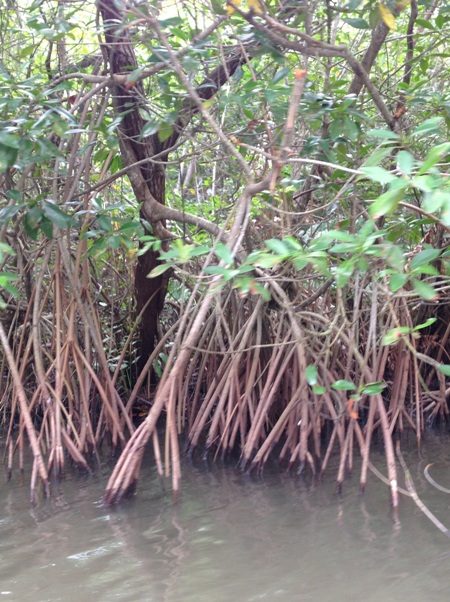
Mangrove in the Laguna de Términos
The Dominicans ran aground on the island of Carmen
"In all, thirty-two persons drowned, including nine monks, and other lay people, in the space of ten hours from 2 a.m. till noon on January 20th, the feast of St. Sebastian, and the storm continued until the afternoon. The storm finally subsided and the boat was pushed to the mainland which they recognized as being the Isle of Términos and, getting closer, they saw Spaniards on the beach, some on horseback, others in canoes maneuvering some difficult crossings, and since they moved slowly, Segovia was able to swim towards them. He told them what happened and moved by their plight, the Spaniards waited for them. Some swam out, others managed as they could, and then an old trader over sixty years of age, very large and heavy and who had saved himself by clinging to planks was hoisted on board, at his own request, without difficulty and by being pulled by his hair and beard, was fastened to a rope and pulled to shore by being towed in the water just like a barrel, as he called himself, and the others dared not joke about the situation. The Spaniards shared their food with them, which consisted of a few corn tortillas, beef jerky, oranges, and thus they were somewhat comforted since no one had eaten anything between Monday morning and Thursday evening”.
(Antonio de Remesal, Historia General de las Indias occidentales y particular de la gobernacíon de Chiapa y Guatemala, Book 5, Chapter 8).
In Campeche, Bartolomé de Las Casas and the Dominicans who remained with him learn about the sinking of the boat. They decide to go to the island of Carmen.
Las Casas sails to the island of Carmen
"Sailors insisted that the Bishop [Bartolomé de Las Casas] and the fathers get on board for departure because weather conditions were ideal for sailing, the sea was calm and the wind favorable. But everyone thought about the death of their brothers and that they were not any better than them and they were afraid that God would strike them in His anger. The Bishop, who went first into the boat, comforted everyone by talking about the Lord’s mercy and their project, which was also his, and using specific arguments he reassured them about the trip on a brand new boat with skilled personnel, a perfect wind and calm seas. He said that the past event had been due to chance, or because of someone’s negligence and that those who sailed around the area rarely got lost. This way he persuaded them to embark, without eating first, but saying a prayer with great devotion […].
"In the midst of these thoughts, the sailors informed the vicar that they had arrived at the place of the disaster. They asked everyone to stand up and they sang a hymn with great solemnity, shedding many tears. The ceremony concluded, the Bishop, just like another St. Paul facing the peril of the sea during his transfer to Rome, asked that the dining table be set, the food cut and he encouraged the others to start eating with great appetite. There was no wind and they did not move until the next day. At 8 am a north wind arose and became stronger. The sailors hurried to reach land as fast as possible and they sailed into the second mouth of Términos Island for almost a mile, and their pain was revived when they found the sunken boat there".
(Antonio de Remesal, Historia General de las Indias occidentals y particular de la gobernación de Chiapa y Guatemala, Book 5, Chapter 9).
Las Casas reaches Tabasco
Las Casas drops some monks on the island of Carmen so they try to find survivors, and crosses towards Tabasco.
Bartolomé de Las Casas is caught in a storm
“His Grace Bishop [Bartolomé de Las Casas] sailed with his companion, Friar Rodrigo de Ladrada and with Friar Pedro Mártir, a cleric who attended to him, and asked that Friars Luis de Cuenca and Jordán of Piemonte come along […] That day, the weather was calm and the next day a dangerous north wind started blowing. They wanted to take shelter in the estuary of St. Peter and St. Paul, but it was night time and it was impossible for the pilot to probe the bottom. They kept sailing in great danger and took confession as a precaution against what could happen. The next night, they suddenly saw a light on shore, which made them happier than seeing the sun in other circumstances. They understood that the light came from Tabasco. They sailed up the river (Grijalva) and, hearing the sailors call, the villagers came out with many torches at the ready, and were told that the Bishop was coming. They greeted him with great demonstrations of joy followed by gifts of food during his entire stay there. There was so much food that he had enough to eat all the way up to Ciudad Real. They gave him all the supplies and equipment that were required to travel on rivers and land”.
(Antonio de Remesal, Historia General de las Indias y particular de la gobernación de Chiapa y Guatemala, Book 5, Chapter 9)

Map of the province of Tabasco, made by Melchor de Alvaro Santa Cruz, Relación Geográfica de la Provincia de Tabasco, 1579, Archivo General de Indias, Sevilla
Frontera, Tabasco, XVIth century:
"At eighty leagues from the city of Merida, the town of Nuestra Señora de la Victoria, located near several large lakes full of fish near the sea, has fifty Spanish settlers, including thirty-six “encomenderos” who are poor, as the bigger exploitation has about 300 Indians, and the rest are merchants. The village was populated by Don Fernando Cortez when he came to discover the coast of New Spain. As the country is very hot and there are no stones and there is a lot of humidity, houses cannot be built with mud bricks or adobe. Instead they are built on high stilts with walls made of simple lattice reeds that let the wind in from the sea. The village moved twenty miles inland in 1553 or 1554 and then returned to its current location because of the proximity of the harbor. The trade of the region is cocoa and cattle spread out on six farms. When we discovered this region, there were many Indians in the Indian villages of Tauasquillo and Taxahual, around twelve to fifteen thousand Indians, whereas today there are not more than fifty, and in the twenty-eight villages of the entire province, no more than a thousand tributary Indians who pay a tribute of two thousand xiquipiles of cocoa, of eight thousand cocoa beans each, broken down by loads of twenty-four thousand each; they also provide four thousand “fanegas” of corn. In total, with other kinds of seeds, cotton textiles and chickens, they pay each year an equivalent of over thirteen thousand ducats, and they are very heavily taxed because many Indians have died and the taxes have remained unchanged. His Majesty has only two villages in this province".
(Geografia y descripción universal de las Indias. Recopied by Juan Lopez de Velasco, from the years 1571 to 1574).
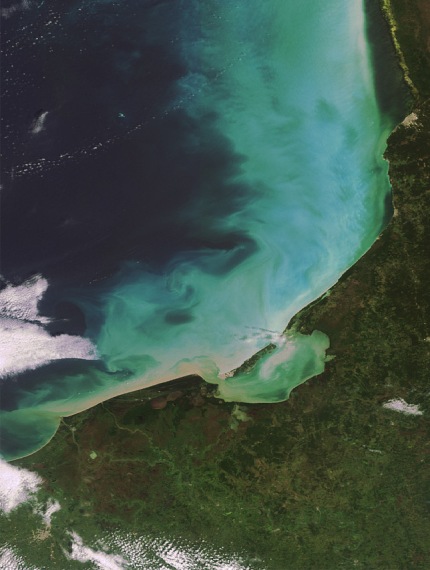
Las Casas’ trip along the States of Campeche and Tabasco. From right to left: The Términos lagoon and the island of Carmen, the mouth of the San Pedro y San Pablo river and the joint mouth of the Grijalva and Usumacinta rivers (satellite view). To the north, the gulf of Mexico.
The Dominicans climb the mountains of Chiapas
From Tabasco, Las Casas moves forward to settle in his diocese as soon as possible. The Dominicans follow, divided into several groups. They sail in a canoe on the Grijalva river and its affluent to Tacotalpa and then proceed to climb to reach San Cristobal (2,200 meters), through the Sierras of Chiapas.
Here is their itinerary in Tabasco and Chiapas:
-Tabasco (Santa Maria de la Victoria – today La Victoria – near Frontera)
-Tacotalpa
-Teapa
-Ixtapangajoya
-Solosuchiapa
-Ixhuatan
-Momostenango (Chamula)
-Ciudad Real de Chiapas (San Cristobal de Las Casas)
Dominicans reach Ixtapangajoya
“FATHER FRIAR TOMÁS CASILLAS and his companions came to a village called Estapangaxoa [Ixtapangajoya] and the vicar was overjoyed to see them all together, healthy and determined to pursue their journey, despite its difficulties which could discourage the boldest and the most daring. The Saturday before the second Sunday of Lent, they departed and the cacique gave them corn tortillas, fish, oranges and bananas to eat while on the road; in order to pay him a little, to show him his friendship and to give him thanks, (that was his way of behaving with all the benefactors), the father vicar gave him trinkets from Castile, including crosses, rosaries, bronze medals and prints to decorate the walls”.
They cross the rugged mountains of the Zoque region
“And to bypass a large river they had crossed the previous day and that was swollen because of heavy rains, and which they would have had to cross four times at great risk if they followed the usual path, they had to take a path known by the Indians alone, that went between huge trees preventing sunlight from reaching the ground, among thickets, brush, stones, rocks, and the fathers were exhausted to climb slopes as straight as cypresses, and they slipped and tumbled down more than they walked. Here they fell, there they got stuck in the mud, lost their footing and were fasting at the same time until it was time to eat, as it was considered a sacrilege not to observe fasting during Lent as strictly as if they were in the cloisters of San Esteban of Salamanca. In fact, they were convinced from the start that the miracles helping them to convert the Indians and bring the Spaniards to live an exemplary life would be the promise of a life full of all kinds of mortification, poverty and withdrawal from society. And so they began, on this hard and uncomfortable pass, to observe the rule that they were to follow in their convent; and so that there would not be lack of choir, the vicar father asked them to sing psalms and hymns in praise of the Lord while they walked. And this exercise was also used, through the singing and the devotion, to distract them from the trouble and fatigue caused by this path that exceeded what could be said or believed”.
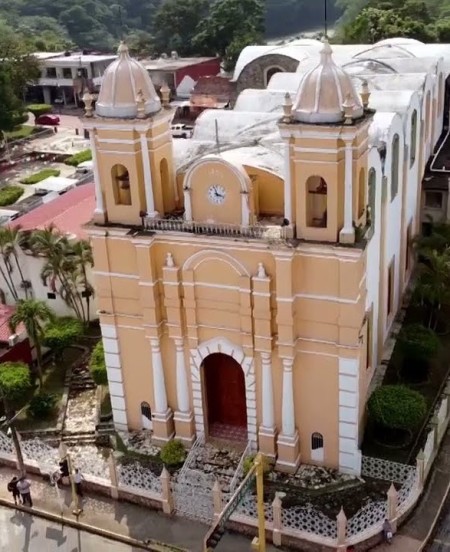
Teapa, a stopping place for the Dominicans (church Santiago Apóstol, 2023, August)
Upon reaching Solosuchiapa, they talk about their adventures
“In the afternoon, they reached a place called Xilosuchiapán [Solosuchiapa] and the cacique welcomed them with great joy and as a sign of pleasure, embraced them all. He would have loved for them to settle there, but it was not possible to give him satisfaction because the place was not appropriate for Sunday celebration and the mosquitoes that were bothering them did not encourage them to stay. They went down the slope, or rather stumbled down as it was very abrupt and steep, and they arrived at a Spanish dwelling but could find no one at home; but they found the father Friar Tomás de San Juan, who was ill and had been sent ahead by Friar Tomas de la Torre, who led his group. Indians were carrying him in a hammock.
This cleric, who had been appointed in Campeche was supposed to sail on the doomed boat but had remained on land by pure chance. When he embarked in Tabasco, the canoe in which he found himself slowly began to slow down and sink, and had he not called loudly to those who preceded him and quickly came to his rescue, he would have drowned. The day prior to the fathers’ arrival, while crossing a river, the Indians carrying him were swept away by the force of the current, and they would all have drowned entangled they were in the hammock if the Lord had not ensured that Segovia, the fathers’ servant who saw what happened, jumped in the water, and being an excellent swimmer, grabbed the cleric and an Indian, encouraged the others despite their helplessness and gave them strength to save themselves. And this was considered a miracle by the fathers who had arrived. They also met there the father Friar Domingo de Medinilla who had remained with Tomás de San Juan who was still recovering from the fright of the incident in the river; with great charity he washed the feet of all the companions who, clean and starving, since dinner had been very light, lay down on racks”.
(Antonio de Remesal, Historia General de las Indias y particular de la gobernación de Chiapa y Guatemala, Book 5, Chapter 12, translated by Chantal Burns).
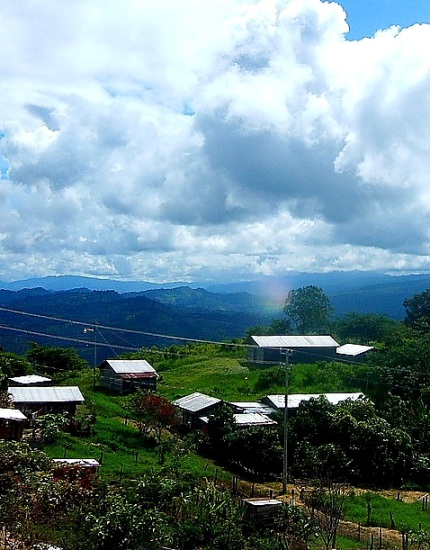
A village at Los Altos de Chiapas
This travel diary was written by Friar Tomás de la Torre, who took part in it. Antonio de Remesal was the first one to use it, rather loosely. Later on, Friar Francisco Ximenez inserted it in his Historia de la provincia de San Vicente de Chiapa y Guatemala (1722). Ximenez certifies that he faithfully captured the meaning of the manuscript. The text written by Ximenez is available in Spanish at OPE Editorial: “Fray Tomás de la Torre, OP, Diario de viaje de Salamanca a Ciudad Real de Chiapas. 1544-1545”. Caleruega, Spain, 1985, available at http://edsanesteban.dominicos.org

Chiapas today, July 3, 2024, tourism forum in the new railway station of Palenque. The Palenque station is one of the most grandiose of all the stations along the route of the "Maya Train"
Domingo Juarros:
"St. Domingo Palenque a village in the province of Tzendales, on the borders of the intendancies of Ciudad Real and Yucatan. It is the head of a curacy; in a wild and salubrious climate, but very thinly inhabited, and now celebrated from having within its jurisdiction the vestiges of a very opulent city, which has been named Ciudad del Palenque; doubtless, formerly the capital of an empire whose history no longer exists. This metropolis, -like another Herculaneum, not indeed overwhelmed by the torrent of another Vesuvius, but concealed for ages in the midst of a vast desert,- remained unknown until the middle of the eighteenth century, when some Spaniards having penetrated the dreary solitude, found themselves, to their great astonishment, within sight of the remains of what once had been a superb city, of six leagues in circumference; the solidity of its edifices, the stateliness of its palaces, and the magnificence of its public works, were not surpasses in importance by its vast extent; temples, altars, deities, sculptures, and monumental stones, bear testimony to its great antiquity. The hieroglyphics, symbols, and emblems, which have been discovered in the temples, bear so strong a resemblance to those of the Egyptians, as to encourage the supposition that a colony of that nation may have founded the city of Palenque, or Culhuacan. The same opinion may be formed respecting that of Tulhá, the ruins of which are still to be seen near the village of Ocosingo in the same district".
(A statistical and commercial history of Guatemala, by Don Domingo Juarros, a native of New Guatemala, translated by J. Baily, Lieutenant R. M., printed by J. F. Dove, St. John’s square, London, 1823)

Fray Bartolomé de Las Casas, Indians' Protector, Biografías Selectas, 1960
2025 "Friars and Mayas"
|

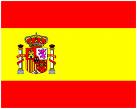
An ocean trip by Giovanni Francesco Gemelli Careri, in "A voyage round the world", 1699:
"The galeon is never clear of an universal iaging itch, as an addition to all other miseries . . . the ship swarms with little vermine, the Spaniards call Gorgojos, bred in the bisket; so swift that they in a short time not only run over cabins, beds, and the very dishes the men eat on, but insensibly fasten upon the body. . . there are several other sorts of vermin of sundry colours, that suck the blood. [...]
"In every mouthful whereof there went down abundance of maggots and Gorgojos chew'd and bruis'd. On fish days the common diet was old rank fish boil'd in fair water and salt; at noon we had Mongos, something like kidney beans, in which there were so many maggots, that they swam at the top of the broth, and the quantity was so great, that besides the loathing they caus'd, I doubted whether the dinner was fish or flesh. This bitter fare was sweeten'd after dinner with a little water and sugar; yet the allowance was but a small cocoa shell full, which rather increased than quenched.
"Providence reliev'd us for a month with sharks and Cachorretas the seamen caught, which, either boil'd or broil'd were some comfort. Yet he is to be pity'd who has another at his table; for the tediousness of the voyage is the cause of all these hardships. [...]
"There are two dangerous diseases in this voyage, more especially as they draw near the coast of America; one is the aforesaid Berben [beri-beri], which swells the body, and makes the patient die talking. The other is call’d the Dutch disease, which makes all the mouth sore, putrifies the gums and makes the teeth drop out. The best remedy against it, is going ashore. This is no other, but the sea-scurvy."
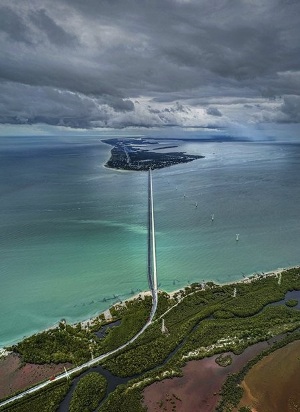
El Zacatal bridge, 3.800 m long, joins Carmen Island to the continent.
The island of Carmen (or Términos): Juan de Grijalva reached the island of Carmen in 1518. Antón de Alaminos, who lead the expedition, named the island Términos, thinking that the Yucatán, believed to be an island, ended there.

Nautical map of Frontera and Rio Grijalva mouth.
The first contact with the Spaniards took place on May 28, 1518, when Juan de Grijalva went up the river of Tabasco, which later was named after the conquistador. A year later, in 1519, Hernando Cortez landed at the same place and defeated the Chontal Mayas in the battle of the plain of Centla. The Spaniards founded the city of Santa Maria de la Victoria, La Victoria today, part of the community of Centla and Frontera.

Frontera, 2023, July. Dance by the Ballet Folklórico de Centla for the nomination of the city of Frontera as "Pueblo Mágico"
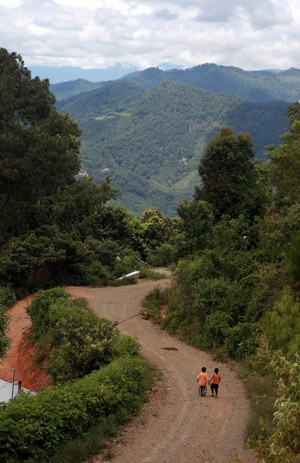
Rancho Bonito, Sierra Madre de
Chiapas
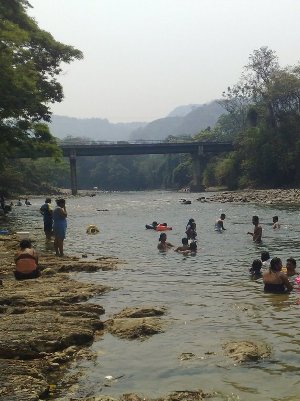
The Río de la Sierra, in Ixtapangajoya
